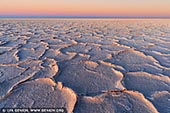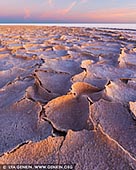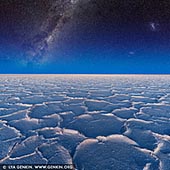Kati Thanda - Lake Eyre
South Australia (SA), Australia
Lake Eyre, officially known as Kati Thanda-Lake Eyre, contains the lowest natural point in Australia, at approximately 15 m (49 ft) below sea level, and, on the rare occasions that it fills, is the largest lake in Australia, covering 9,500 km2 (3,668 sq mi). The shallow endorheic lake is the depocentre of the vast Lake Eyre basin and is found in Northern South Australia, some 700 km (435 mi) north of Adelaide. When the lake is full, it has the same salinity level as the sea, but as the lake dries up and the water evaporates, salinity increases. The lake was named by Europeans in honour of Edward John Eyre, who was the first European to see it, in 1840. The lake's official name was changed in December 2012 to combine the name 'Lake Eyre' with the indigenous name, Kati Thanda. The native title over the lake and surrounding region is held by the Arabana people.
Located north of the Oodnadatta Track in a dry and isolated environment, the lake, is a mind-blowingly vast, dry expanse of shimmering salt in the South Australian outback. On cloudless days, the reflections become so remarkable that it can be difficult to distinguish between land and sky. Lake Eyre is actually divided into two sections: Lake Eyre North and Lake Eyre South. These sections are joined by the narrow Goyder Channel. Most of the time Lake Eyre is covered by an immense dry salt pan. This immense expanse of salt crusts reflects the rays of the fierce outback sun, creating a harsh, scintillating glare that reminds one of an alien landscape. The surface of the lake is 15 metres below sea level. The salt crust is up to 250 cm thick. The surrounding area is covered by gibber stones and the whole area is walled in by red dunes.
In 1964 the salt crust was thick enough to allow Sir Donald Campbell to race his jet-powered Bluebird-Proteus CN7 car and successfully reach the world land speed record of 648.73 kilometres per hour (403.10 miles per hour) on 17 July 1964. Lake Eyre has only been full of water seven times since European settlement. In 1974-77 flooding rains in Queensland, the Northern Territory and South Australia filled Lake Eyre with water. In that period the waters of the lake stretched for a length of 140 km and the depth of the floodwaters reached a record height of 6 metres (20 ft).
About the Artist
I'm Ilya Genkin - an internationally recognised Australian landscape and fine art photographer offering wall art prints. My passion for capturing the beauty of nature and our world translates into striking photographic prints that bring life, emotion, and inspiration to any space. From tranquil seascapes to dramatic mountainscapes, each image is a reflection of my vision and dedication to the art of photography.
Read more about Ilya Genkin and shop fine art prints online from his collection.
Wall Art Prints Featuring Fine Art Landscape Photography
Explore my extensive collection of wall art prints - crafted with the highest-quality materials to suit every style and budget. Whether you're looking for a luxurious, ready-to-hang piece or a beautifully printed work to frame yourself, each photograph is available in several premium formats: Gallery-quality Fine Art Paper Prints - ready for framing, and Professional Canvas Prints - classic and timeless texture.
Each artwork is meticulously printed and made-to-order to ensure you receive a piece that elevates your home, office, or commercial space. Buy fine art prints online to suit your style.
Artworks for Interior Designers, Home Stylists, and Architects
I collaborate with interior designers, home stylists, and architects to create bespoke wall art prints tailored to your project's aesthetic, colour palette and interior design needs. Prints can be customised and sized to complement your space perfectly. All pieces are made-to-order, and pricing varies based on size, quantity, and shipping.
Contact me to discuss your project and request a personalised quote.
Why Choose Ilya Genkin Photography?
By choosing my work, you're not just acquiring exceptional art - you're supporting an independent Australian artist and contributing to a vibrant local creative community. Every purchase directly helps sustain and grow this craft, bringing authentic and meaningful art into your life.
Request a free mockup to see how a chosen photograph will look in your space before you buy.
Start your journey today - shop our wall art collection, purchase with confidence, or order custom prints today and transform your walls with fine art photography.
Fine Art Landscape Photography
Information
Photography Guides
Online Store Opens 24/7
Email:
Phone: +61 (0) 421 055 613
Crafted with care for the planet - using sustainable materials and eco-friendly packaging.
Ilya Genkin Photography acknowledges the Traditional Custodians of the land on which we operate, live and gather as employees, and recognise their continuing connection to land, water and community. We pay respect to Elders past, present and emerging.




